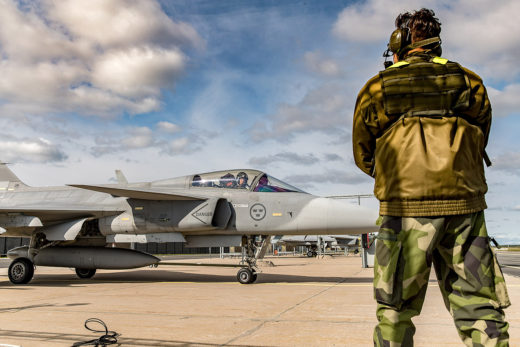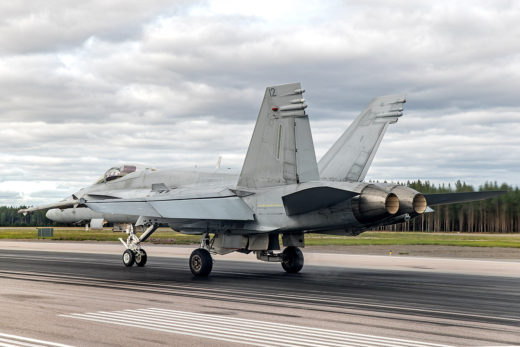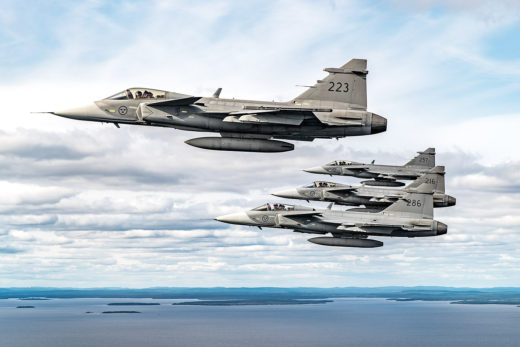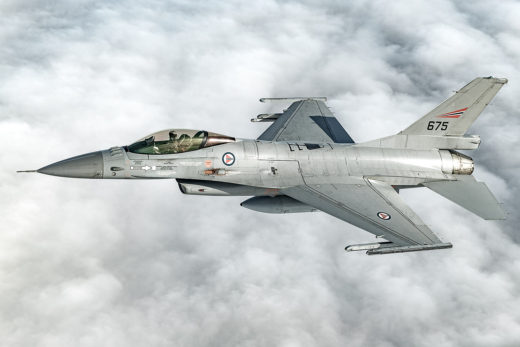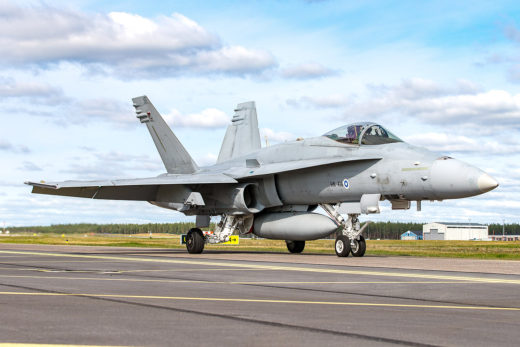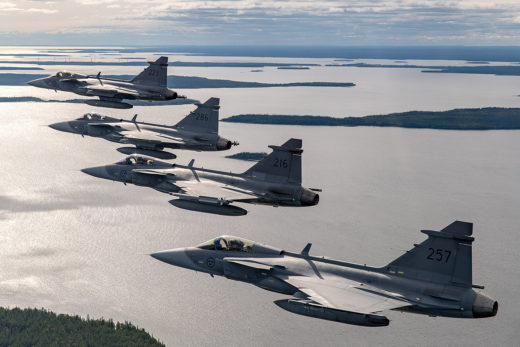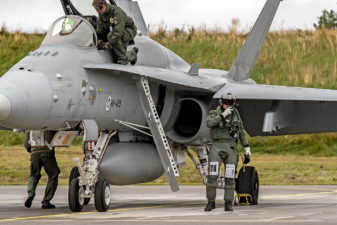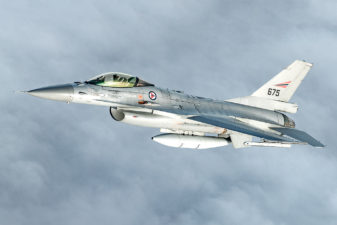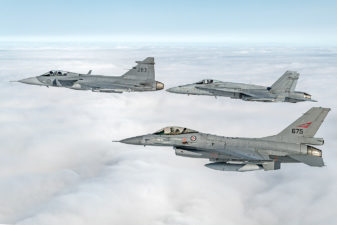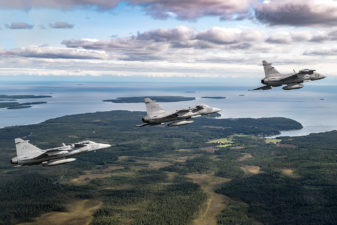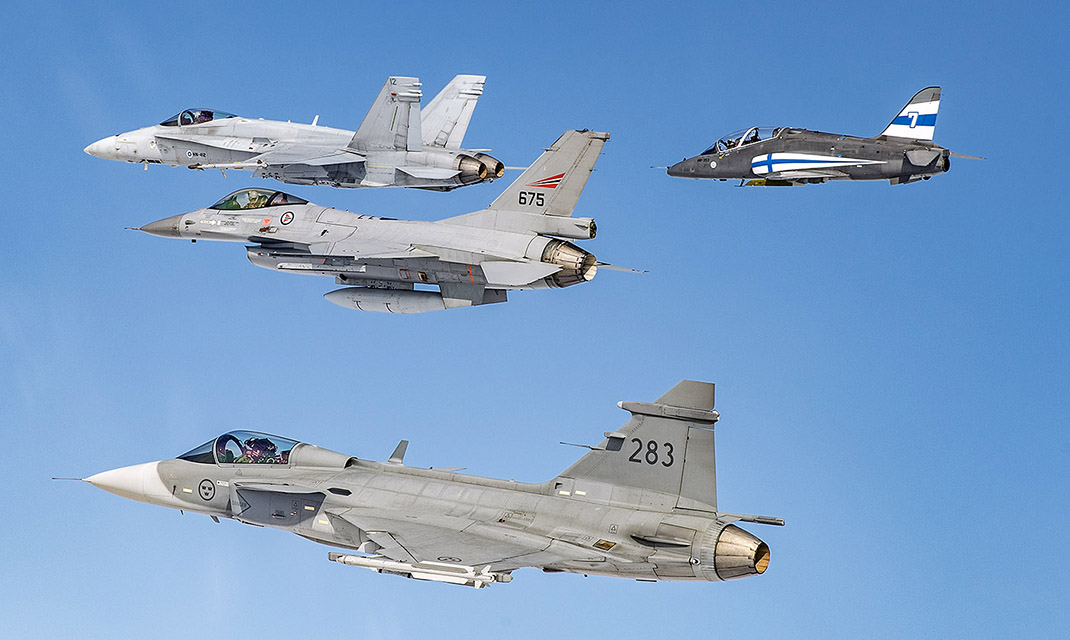
Cross Border Training
The Nordic countries of Sweden, Finland and Norway have discovered a way to optimize
their daily training to include
training scenarios with and against other squadrons from other nations, without any of the parties having to deploy.
training scenarios with and against other squadrons from other nations, without any of the parties having to deploy.
|
Cross Border Training
Each of the nations has an airbase geographically located close to each
other, with Bodø in Norway to the west, Kallax in Sweden in the middle, and
Rovaniemi in Finland to the east – giving the three nations a low cost, and
efficient way to do training sorties, and train interoperability with
dissimilar airframes from other nations, on a daily basis.
It all started with a political decision in 2000, where it was decided that Finland and Sweden should start working closer together and utilize the potential of NORDEFCO (Nordic Defence Cooperation) across the borders of the two countries. Lt Col. Peter ‘Restless’ Greberg, Squadron Commander 211 Fighter Squadron of the Swedish Air Force at Norrbottens flygflottilj F 21, explains, “From an economic point of view, it’s very efficient and very good. It’s a cost-efficient training. It takes the cooperation between the countries even further, based on the NORDEFCO, where all the Nordic countries want to cooperate, and we just wanted to take this a bit further, and that’s how Cross Border Training started.” This was the start of what is known today as the Cross Border Training (CBT) program, starting out with a close cooperation between Finland and Sweden, in a bilateral training program between the two nations, utilizing the big airspaces to the north. |
The change in mindset
Each of the nations has an airbase geographically located close to each
other, with Bodø in Norway to the west, Kallax in Sweden in the middle, and
Rovaniemi in Finland to the east – giving the three nations a low cost, and
efficient way to do training sorties, and train interoperability with
dissimilar airframes from other nations, on a daily basis.
It all started with a political decision in 2000, where it was decided that Finland and Sweden should start working closer together and utilize the potential of NORDEFCO (Nordic Defence Cooperation) across the borders of the two countries. Lt Col. Peter ‘Restless’ Greberg, Squadron Commander 211 Fighter Squadron of the Swedish Air Force at Norrbottens flygflottilj F 21, explains, “From an economic point of view, it’s very efficient and very good. It’s a cost-efficient training. It takes the cooperation between the countries even further, based on the NORDEFCO, where all the Nordic countries want to cooperate, and we just wanted to take this a bit further, and that’s how Cross Border Training started.” This was the start of what is known today as the Cross Border Training (CBT) program, starting out with a close cooperation between Finland and Sweden, in a bilateral training program between the two nations, utilizing the big airspaces to the north. |
|
|
|
|
Trilateral
It’s been around for many years, the realization that countries like Sweden
will fly in some of the coalition operations, next to NATO members. With
the coalition warfare mindset, new challenges arose that needed to be faced
and solved, as Lt Col. ‘Folder’ illustrates, “When the political
go-ahead was given for closer cooperation between NATO air forces, and
non-NATO air forces, to do these kind of exercises, it was quite
exciting. It gave us more training opportunities. Along with that,
there were parallel efforts, both between fighter squadrons and also
the command and control centres, to achieve a higher degree of
standardization. At the start up the gap was quite huge, as you had a
NATO culture, and a set of TTPs (Tactics, Techniques and Procedures),
that were quite different from non-NATO countries. That could be
everything, like just the way you talk on the radio, like ‘Bingo fuel’
and so on.”
Lt Col. ‘Folder’ continues, “Then it’s easier to say that you have identified a pretty hard requirement; that we need to get them on board with our procedures, and how we (NATO members ed.) conduct operations. It’s the same way that NATO countries used to do exclusively, for exactly the same purpose, and now we see the benefits and gains, by doing it with the partnering nations.” Norway is, besides being a member of NATO, a member of the NORDEFCO collaboration, which has as its main aim and purpose to strengthen the participating nations’ national defences, explore common synergies and facilitate efficient common solutions. The partnership in NORDEFCO and the change in mindset of NATO opened up for new possibilities, as Lt Col. ‘Folder’ explains, “It’s well known that the interest for Nordic Defence Cooperation (NORDEFCO) has always been there, but it has been more in the open for the last 15-20 years, where it gradually had the opportunity to have more cooperation. I think in that sense the initiative has been broad. This is an example of how you are able to use that initiative for good training, but also for the lower level, a little of the bottom up approach, at our level – at the squadrons, there was a positive and proactive mindset, really looking into, what we can achieve within this framework, and the new opportunities that raised a few years ago.” Based on the changes and political decisions, Norway noticed the advantages of the CBT program, not only training against dissimilar aircraft, but also integrating with other non-NATO nations on a daily basis, would benefit both themselves, and the other nations. Furthermore, the big remote areas in the northern part of Sweden would give RNoAF access to facilities not seen in Norway, as Lt Col. ‘Folder’ explains, “Other advantages we identified, if you look at the map and look at the possibilities with airspace – in particular northern Sweden with big remote areas, where there are big airspaces for air-to-air training. That was clearly very attractive, because there will, a lot of the time, be difference in weather when looking at the coast of northern Norway compared to inland, like Sweden.” |
“Other advantages we identified, if you look at the map and look at
the possibilities with airspace – in particular northern
Sweden with big remote areas, where there are big airspaces for
air-to-air training.”
Norway joining the programme
This lead to Norway joining the Cross Border Training program in 2009,
taking advantage of the entire CBT package, as Lt Col. ‘Folder’
illustrates, “If you look at it from our perspective in Norway, for both
Bodø and Ørland, when we were only oriented towards other NATO air
forces, we were limited if we wanted to do something from our home
bases, as opposed to go to the Red Flag in the US of course, which was
the type of the solution we had to go for.
So once the Cross Border-era kind of started to evolve, we could all of a sudden see that we had an excellent airspace, and the advantages of training from our home bases with, and against, mixed formations.” |
|
|
|
|
The training order
What started more than fifteen years ago as small basic air to air
engagements training, has now grown into one of the most effective daily
training programs you can find anywhere in the world, utilizing the massive
airspace of the remote and deserted northern part of Finland, Norway, and
Sweden.
Today, the Cross Border Training program is a large operation, where the squadrons at the three northern bases put in a wish-list of what kind of training they want. It can range from a large forces deployment, to simple basic training for the students of the squadrons. This wish-list is then once a year conducted into the operational plan for the Cross Border Training program. The plan is to have 40 events a year. This is then revisited after six months to check if they are sticking to the plan, as Major Jouni Turula, Fighter Squadron 11 of the Finnish Air Force at Rovaniemi states, “We make a CBT training order for the entire year, and we schedule the sorties in that. We want to make a lot of them, as they are easy to cancel if something comes up so we cannot participate – it’s harder to put new ones in it. The CBT sorties are planned for almost every week, and it gives around a CBT sortie every second month for each pilot.” |
|
|
|
|
|
Only benefits
The big benefits of the CBT program are the low cost, the flexibility, the
big airspaces, and the interoperability with other nations. The aircraft
fly from their home bases, fight, and return to their home bases. It’s the
same as a regular training sortie with the local units.
One of the unique aspects of CBT is the way that the communication, planning, briefing and debriefing are done. The squadrons have a Video Tele Conference (VTC) system setup, so that they can do briefing and debriefing ‘face-to-face’, even though they are not located at the same airbase. They do the mission planning in a special internet portal, where all the mission commanders put in their planning. All of the briefings and debriefings are also stored in this portal. In this way, everybody can evaluate the facts of the missions, and this gives the squadrons a unique opportunity to enhance their training. Even though the three countries are neighbours, there are still small cultural differences, and this is also present within the air forces and fighter squadrons that might do things in a slightly different manner. This is not a disadvantage – quite the opposite! It could result in the other nations gaining strategic or technical ideas that could be implemented to their training, as Lt Col. ‘Folder’ summarizes, “Maybe we can practice this more, or this is a better way of doing things, that could be interesting for us.” Some days there’s two nations fighting each other, other days it’s all three nations joining the fight, where a typical trilateral force could be eight Swedish JAS 39 Gripens, and two Norwegian F-16s working together against six F-18s from Finland. The nations share the burden as Red air, where they try to have every second sortie as the ‘enemy’ doing as they please. The sortie is built up upon what the ‘good guys’ want. Red air will then play the role desired by the other units. In this way, you get as much variation as possible, but also optimizing your training to be specific to what you want to train for, whether it’s offensive counter air, defensive counter air, large scale deployment scenarios or whatever the squadron wants. |
|
|
|
|
|
Geographical advantages
The geographical location of the three bases gives big advantages for the
three air forces, making it possible for them to train together and make
use of each other’s airspace, as Maj. Turula explains, “The other
fighter squadron that has F-18s here in Finland is quite a lot further
south of Rovaniemi, so basically the closest fighter squadron we have
is at Kallax. It’s really cost efficient to train with the Swedes here
in Lapland.
The airspaces in the northern part of Finland and Sweden are very good, with very limited commercial traffic, which basically means we have unlimited vertical airspace most of the time, so it’s really easy to train here.” Although the three bases are close to each other, it’s not only those bases that gain benefits of CBT, as the other squadrons of the nations from time to time are a part of the CBT sorties. Maj. Turula explains, “If we fly a bilateral sortie between Finland and Sweden, then we can use the airspace south of Rovaniemi that is closer to Kuopio, which enables them (Fighter Squadron 31 at Kuopio ed.) to participate. Or they can land at Oulu, which is one of our alternatives, and refuel there, participate and fly home.” |
|
|
|
|
|
Arctic Challenge Exercise
As an air force, and even as a squadron, you cannot just deploy on an
internal mission, without being prepared, which takes training and
practice, especially if you’re joining a coalition operation.
The practice and training can be achieved in many ways, but the most common method is to deploy to an international exercise, and gain valuable experience through the exercise. When you have the biggest airspace in Europe, with some of the best weapon ranges in the middle of it, then why not bring the exercise to you? The three countries took all the benefits and experience from CBT -and the requirement to be prepared – and enlarged the CBT package with the Arctic Challenge Exercise (ACE). An exercise first held in 2013, taking all the advantages of CBT, utilizing all three bases for the exercise. It was something that was unproven as Lt Col. ‘Restless’ explains, “If we look back at ACE, then it’s a direct spin-off of CBT. Everything ACE is based on, was first tested and developed from CBT. ACE is CBT on a larger scale. In 2013, for the first ACE, we were a little bit worried as we had participants deployed to three different bases. When we had previously been participating in exercises, all had been deployed to one airbase. Now the participants were at three different air bases, in three different countries. We used the VTC facilities to do all the planning, briefs, and debriefs. We thought ‘How is this going to work on such a large scale?’. We knew it was tricky just in the CBT environment, and that is not that many aircraft.” |
Experience gained
It was an unnecessary concern, as Lt Col. ‘Restless’ adds, “The funny
thing is that one of the main pros from the other countries, during ACE
13, was ‘It’s perfect that we are on different bases, because that is
the real world. We would never meet in one single planning room, where
everybody plans together – everybody will be spread out’.”
They took the experience gained at the first ACE, with the unknown elements that worked better than expected, and brought, and is continuously bringing, ACE to a higher level. As Lt Col. ‘Restless’ continues, “That was kind of an awakening, that this new concept, worked so very good. We continuously try to improve that, making all the facilities, planning rooms, VTCs better, to facilitate the planning, briefs etc. even better. All the things we were worried about in the early days, have now been beneficial for the exercise. Everybody thinks it’s good.” Another benefit of having the aircraft spread out, is that having that many aircraft on a single base – with a single runway – limits the amount of launches you can have. Thereby also limiting the possible scenarios for the exercise. Spreading them out on three bases, gives three times the capability and makes the perfect scene to train real world scenarios, as Lt Col. ‘Restless’ concludes, “You have the possibility to build real world scenarios, flying from different bases, meeting in the air, and do the sortie together.” Lt Col. ‘Folder’ adds, “During ACE 17, there were more than 100 aircraft. You do the planning via the VTC tool – that’s different from sitting around the table – but that’s also realistic training, because that’s how recent combat operations have been done as well, where you are spread out on multiple bases.” |
|
|
|
|
ACE led to special events
The major benefits and possibilities of CBT have been noticed around the
NATO community, as Lt Col. ‘Restless’ concisely adds, “The reputation
grew.”
The interest in CBT from other countries has been growing, and it’s not only the Nordic countries now taking advantage of it, what with the huge airspaces available, and the possibility to fly against dissimilar airframes. Two years ago the so called ‘Special events’ in the CBT program started, which included a couple of F-15 Eagle formations from RAF Lakenheath, being dragged by a RAF Mildenhall KC-135 tanker, to take part in a CBT sortie in the north, and return to RAF Lakenheath. Lt Col. ‘Restless’ explains, “The US Air Force participated in the first ACE, and saw the advantages of the big airspace and the possibility to train with many fighters on a day to day basis. That’s how it all started, and they said, ‘Hey we want to chip in on this’. Which is why we created the ‘Special Event’.” Adapting to the situations
What was a priority yesterday, may not be a priority today, as the world is
changing with new situations and potential crises lurking, the focus also
shifts in the armed forces around the world. Something that can also be
seen in the ever-evolving CBT, as Lt Col. ‘Restless’ explains, “We have
been very focused on international types of missions here, which means
peace support and peace enforcement operations, as ACE has these kinds
of scenarios. I think that most of the air forces around the world are
now looking back to basics, which means national defense is once more
on the agenda, and we’re not that large scale anymore, we might be on
our own.
What we have been trying to do, is to implement a little bit more of a national scenario, with a high threat environment. A couple of years ago we mostly trained against a medium level threat, but now we’re more focused on a high threat environment, so we need to go in low – we can’t go mid level anymore.” Changing the focus from international operations to more national oriented operations, but still keeping the international readiness, is a fine balance. The combination of CBT and ACE seems to be the key for the Nordic countries, as Lt Col. ‘Restless’ continues, “Adjusting to the different crisis scenarios. We need to continuously improve CBT. When we launched CBT on a really large scale, we had 65 occasions a year. There’s actually a reduction now, and this year we only have 40. That’s because when something is new everyone is eager. But it also takes a lot of resources to plan and adapt to the different situations, both for the squadrons and from a political side – to come to fruition. We’re looking at the bilateral meet up differently than we did five or six years ago. Now we can do a lot of good stuff with them, instead of doing basic BVR (beyond visual range ed.) setups, we can actually bring in scenarios, where four adversaries are ample to fulfil our goals. Earlier we just looked at large scale scenarios all the time – it’s still interesting, and we still need to train it, but not on the same scale as before. The smaller scenarios are equally useful for us, to reach our goal.” Even though it’s not the large-scale scenarios that are the main focus of CBT, it’s still a part of CBT, and in combination with ACE, this keeps the squadrons on a high level of readiness and interoperability with other units, as Major Turula explains, “We are training to be interoperable with NATO, as we’re not a part of NATO, but under the NATO ‘Partnership for Peace’. With Norway being a NATO country, flying CBT sorties with the their F-16s helps us to know how the NATO work.” |
“Adjusting to the different crisis scenarios. We need to continuously
improve CBT.”
Interoperability is the key
Lt Col. ‘Restless’ adds, “CBT is easy, and extremely useful, to keep a
sufficient amount of interoperability in the squadron. To reach these
goals, before we had CBT, we needed to travel to the Netherlands, or
the US, otherwise it wasn’t possible. Before CBT came about we needed
to go to the bigger exercises, deploying to other countries. It’s very
expensive with only a few pilots at a time. Now we can actually train
more pilots during the year. It’s been very beneficial.”
It’s important for the countries involved in CBT to be ready to handle an international crisis if need be. This is where ACE helps the squadron be ready, and train these coalition scenarios in their regular training, as Lt Col. ‘Restless’ illustrates, “Interoperability is the key to success. No matter how the crisis may look like, if it’s in Europe or anywhere else in the world, interoperability is the key. We were very focused on the global situation fifteen years, where we were going to do peace enforcement, or peace support operations, and we needed to train for that. We did not prioritize how to fight in Sweden, to defend our self. Presently we’re back, focusing on national defense, and now it includes interoperability, and that is ACE for me.” All the scenarios can be trained in the CBT package, to be ready to handle the real world, as Lt Col. ‘Restless’ concludes, “If you look at how we have been flying the last ten years, one large exercise every second year (ACE ed.), in combination with CBT, that will be totally sufficient for us, to maintain our interoperability level – so that is ACE for me.” |
|
|
|
|
Arctic Fighter Meet
Once a year the participating squadrons arrange an actual meeting with the
units meeting face to face at one of the three air bases. The location
changes every year, and this year it was held at Kallax. This is called
Arctic Fighter Meet (AFM), which is a great opportunity for the pilots to
meet, and shake the hands of the other pilots they fight with and against,
and do video conferences with. It creates a strong connection, and
relationship between the squadrons across the borders.
The meeting is invaluable and it gives the squadrons a chance to learn the pros and cons from the other squadrons. During AFM some of the more experienced pilots from one nation, fly with the younger, and less experienced pilots from another nation – a method that benefits all the players. There’s different ways to flying the airframes, and with most of the modern missiles and weapon systems these days the most predictable outcome of any engagement against an enemy would result in a BVR fight, but as Lt Col. ‘Folder’ states, the good old fashion dog fighting is still an important aspect of their training, and CBT – and especially AFM – facilitates this kind of training: “This fighter meet in particular is all about getting back to basics, such as one-on-one. Maybe the awareness wasn’t there twenty years ago. We started to get new systems, new missiles, and the training would start to shift away from the visual engagement. I think it’s nice to see that we are now embracing this component of our training. Even though we’re hoping that at the time we hit the merge with the adversary, that the outcome has already been decided (the enemy has been shot down ed.). But if that’s not the case, you of course have to have a plan for what to do next, if you actually find yourself there.” “The future for CBT is good, and we’re always trying
to improve it. We should not be satisfied with how it is, and we
should always try to improve it. If we want it to be as
productive as it has been for the past ten years.”
|
Developed by pilots, for pilots
If you was to give AFM a motto, it would most likely be something as simple
as ‘Developed by pilots, for pilots’, as Lt Col ‘Restless’ illustrates, “I
love AFM, it’s brings us back to the very basics of flying. To keep it
easy, we just keep it to BFM (basic fighter manoeuvres) all the time.
There shouldn’t be any big planning, or evaluation. The most important
thing about AFM is to be at the same place, to meet – to get to know
each other. That’s equally important, as it is to fly.”
AFM is all about going back to basics, and getting to know the other pilots from the other countries, building a social bond, as Major Turula concludes: “It’s a good thing with AFM to do briefings and debriefings face-to-face for the young pilots, because in the near future they will fly the CBT sorties and brief and debrief across the VTC. AFM gives them an opportunity to build a relationship with the other nations’ pilots. It’s a lot easier to brief and debrief when you have met the other pilots previously – put a face to the name.” The future
No one can predict the future, but the CBT package is helping the squadrons
of the Nordic countries to adapt to the ever-changing global situation, as
Lt Col. ‘Restless’ explains, “The future for CBT is good, and we’re
always trying to improve it. We should not be satisfied with how it is,
and we should always try to improve it. If we want it to be as
productive as it has been for the past ten years.”
The typical BVR scenario might not work in all situations, the conflict or situation is not aggressive, but more defensive, protecting your borders, by being present in the air, to show air superiority, as Lt Col. ‘Restless’ illustrates, “It has always been a focus to have the younger pilots, to have an environment, to learn how to fly against dissimilar aircraft. Doing BFM manoeuvres – does it bring us further in some war-type tactical scenario? No, but it’s a way to know how to use your aircraft in different situations, because it’s not only peace and war. You can find yourself up there, in various states of crisis, and then being able to manoeuvre your aircraft, and learn your aircraft against dissimilar ones, that is the main achievement.” Lt Col. ‘Restless’ concludes, “CBT is the perfect platform to prepare for real world scenarios.” The author would like to thank Major Jouni Turula, Lt Col. Erik ‘Folder’ Brettingen, and especially Capt. Daniel ‘Northug’ Strand, Louise Levin, Chief of Public Affairs Norrbottens flygflottilj F 21 and Lt Col. Peter ‘Restless’ Greberg for making this article possible. |
|
|
|




